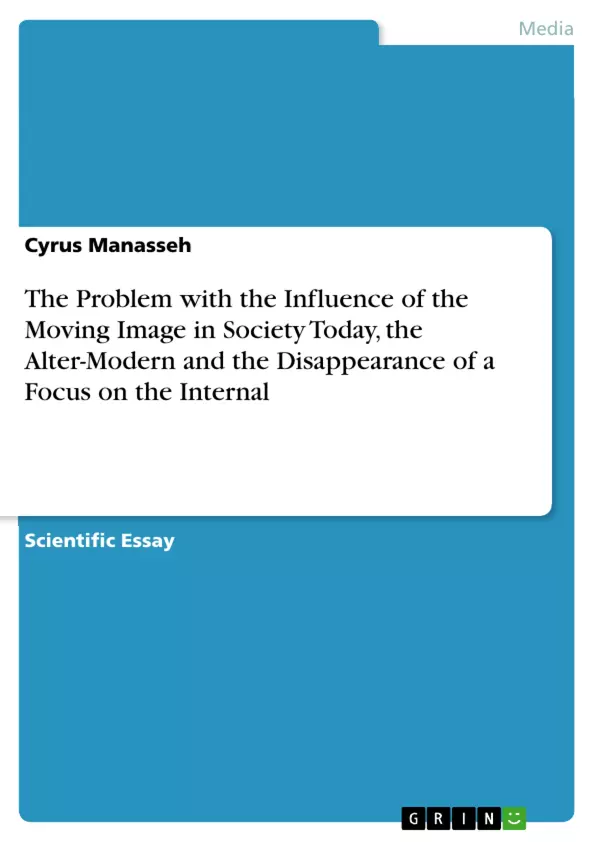Since the early twentieth century, civilization’s obsession with the moving image has helped it to go backwards instead of forwards. Because of the nature of the way moving images are proliferated especially during our present age of digital expansion, the past and the history of the past produce a cultural amnesia which creates a misperception that we are greatly ahead of our past.
Much of this is because our continuous fascination with the moving image has undermined and effaced a Modernist reasoning which had been more concerned with searching for an internal depth in objects and things which were reflected in the human being. As a result of our visual thirst for the moving image which takes us away from this, we now live in a situation void of causal reasoning which makes it very easy for very little reason, or difficult, for well-justified reasoning to exist since our thirst and addiction to the moving image has seen a spiritual shift away from the search of internal value and meaning that has been tied to our culture and cultural perceptions.
By tracing civilization’s obsession with the Classical which it had once used as a ‘steadying metaphor’ the paper attempts to explain some of the influences that have made us lose our focus on the importance of the internal and offers to explain why we are now more than ever before bereft of a focus for searching for the internal depth that exists within people, objects and things.
Inhaltsverzeichnis (Table of Contents)
- Problems Today.
- Moving Images
- The Classical and the Instinctive Attraction to the Idea of the Limited Whole: A Reflection of Civilisation's Need for a Steadying Metaphor
- A New Global Reflex and Steading Metaphor in the Twentieth Century
- Today's Alter-Modernism
- Conclusion
Zielsetzung und Themenschwerpunkte (Objectives and Key Themes)
This paper explores the impact of the moving image, particularly in the digital age, on our cultural understanding and perception of the world. It argues that the increasing reliance on visual media has led to a decline in our ability to engage with internal depth and meaning.
- The influence of the moving image on cultural perception
- The shift from internal focus to surface-level engagement
- The role of technology in shaping our understanding of knowledge and reality
- The loss of boundaries and the rise of a globalized culture
- The consequences of a culture dominated by digital logic and hyper-textuality
Zusammenfassung der Kapitel (Chapter Summaries)
- Problems Today: This chapter introduces the concept of "Alter-Modernism" and argues that the dominance of moving images, especially digital ones, has created a culture of superficiality and diminished our ability to engage with internal depth. It highlights the problems associated with the digital world's lack of boundaries, shared morals, and objective contexts.
- Moving Images: This chapter delves deeper into the impact of moving images on our cultural perception. It argues that the proliferation of visual media has led to a shift in focus from internal meaning to surface appearances, undermining the importance of causal reasoning and creating a culture of instant gratification.
- The Classical and the Instinctive Attraction to the Idea of the Limited Whole: A Reflection of Civilisation's Need for a Steadying Metaphor: This chapter explores the historical context of the moving image, tracing civilization's obsession with the Classical as a "steadying metaphor." It argues that this obsession has influenced our current reliance on visual media and contributed to our loss of focus on internal depth.
- A New Global Reflex and Steading Metaphor in the Twentieth Century: This chapter examines the emergence of a new global reflex in the 20th century, shaped by the rise of technology and the internet. It argues that this new reflex has further intensified the shift away from internal meaning and towards a culture of superficiality.
- Today's Alter-Modernism: This chapter explores the characteristics of contemporary Alter-Modernism, emphasizing the dominance of digital logic and hyper-textuality. It argues that this environment has led to a false sense of control and knowledge, undermining our ability to cultivate individual interpretations and insights.
Schlüsselwörter (Keywords)
The primary keywords and focus topics of the text include Alter-Modernism, moving images, digital culture, internal depth, superficiality, cultural perception, technology, globalization, hyper-textuality, and the loss of boundaries.
- Citation du texte
- Cyrus Manasseh (Auteur), 2016, The Problem with the Influence of the Moving Image in Society Today, the Alter-Modern and the Disappearance of a Focus on the Internal, Munich, GRIN Verlag, https://www.grin.com/document/316246



